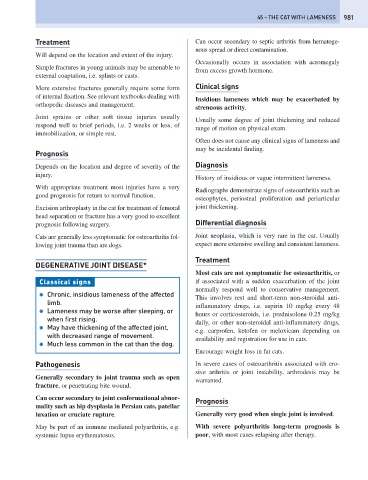Page 989 - Problem-Based Feline Medicine
P. 989
45 – THE CAT WITH LAMENESS 981
Treatment Can occur secondary to septic arthritis from hematoge-
nous spread or direct contamination.
Will depend on the location and extent of the injury.
Occasionally occurs in association with acromegaly
Simple fractures in young animals may be amenable to
from excess growth hormone.
external coaptation, i.e. splints or casts.
More extensive fractures generally require some form Clinical signs
of internal fixation. See relevant textbooks dealing with
Insidious lameness which may be exacerbated by
orthopedic diseases and management.
strenuous activity.
Joint sprains or other soft tissue injuries usually
Usually some degree of joint thickening and reduced
respond well to brief periods, i.e. 2 weeks or less, of
range of motion on physical exam.
immobilization, or simple rest.
Often does not cause any clinical signs of lameness and
may be incidental finding.
Prognosis
Depends on the location and degree of severity of the Diagnosis
injury.
History of insidious or vague intermittent lameness.
With appropriate treatment most injuries have a very
Radiographs demonstrate signs of osteoarthritis such as
good prognosis for return to normal function.
osteophytes, periosteal proliferation and periarticular
Excision arthroplasty in the cat for treatment of femoral joint thickening.
head separation or fracture has a very good to excellent
prognosis following surgery. Differential diagnosis
Cats are generally less symptomatic for osteoarthritis fol- Joint neoplasia, which is very rare in the cat. Usually
lowing joint trauma than are dogs. expect more extensive swelling and consistent lameness.
Treatment
DEGENERATIVE JOINT DISEASE*
Most cats are not symptomatic for osteoarthritis, or
Classical signs if associated with a sudden exacerbation of the joint
normally respond well to conservative management.
● Chronic, insidious lameness of the affected
This involves rest and short-term non-steroidal anti-
limb.
inflammatory drugs, i.e. aspirin 10 mg/kg every 48
● Lameness may be worse after sleeping, or
hours or corticosteroids, i.e. prednisolone 0.25 mg/kg
when first rising.
daily, or other non-steroidal anti-inflammatory drugs,
● May have thickening of the affected joint,
e.g. carprofen, ketofen or meloxicam depending on
with decreased range of movement.
availability and registration for use in cats.
● Much less common in the cat than the dog.
Encourage weight loss in fat cats.
Pathogenesis In severe cases of osteoarthritis associated with ero-
sive arthritis or joint instability, arthrodesis may be
Generally secondary to joint trauma such as open
warranted.
fracture, or penetrating bite wound.
Can occur secondary to joint conformational abnor- Prognosis
mality such as hip dysplasia in Persian cats, patellar
luxation or cruciate rupture. Generally very good when single joint is involved.
May be part of an immune mediated polyarthritis, e.g. With severe polyarthritis long-term prognosis is
systemic lupus erythematosus. poor, with most cases relapsing after therapy.

